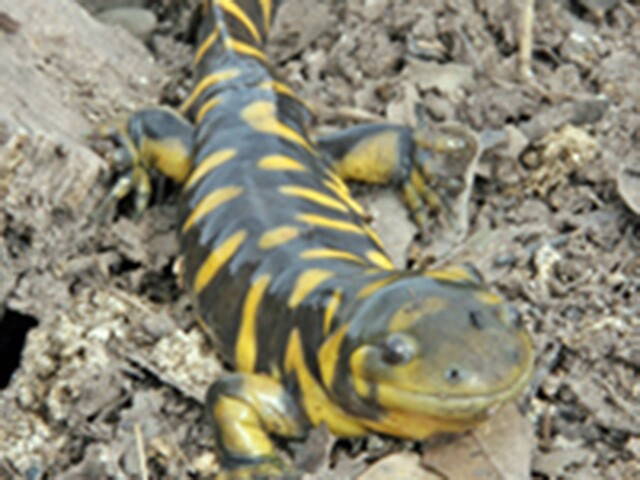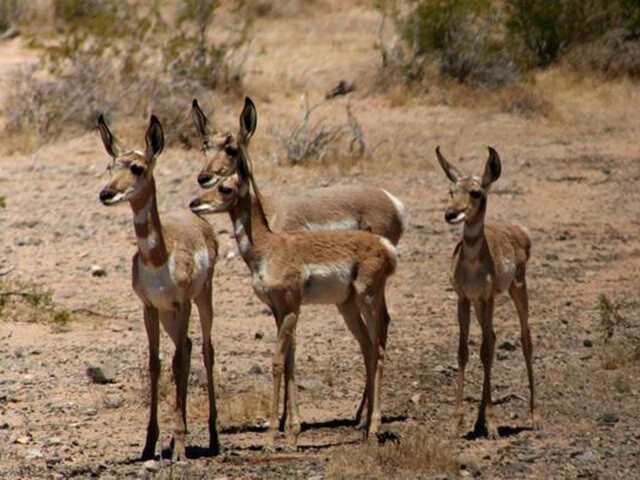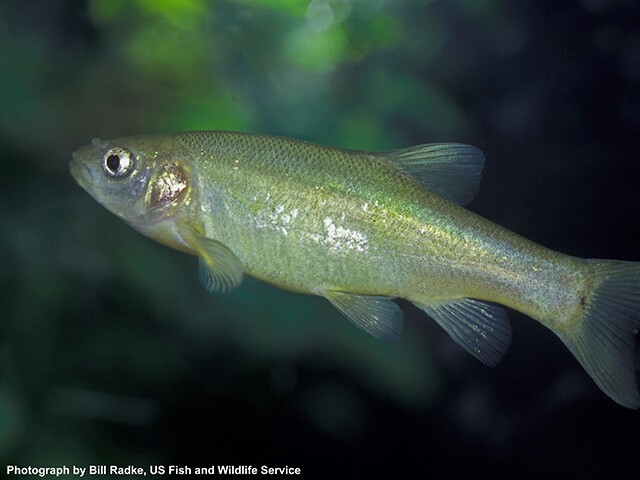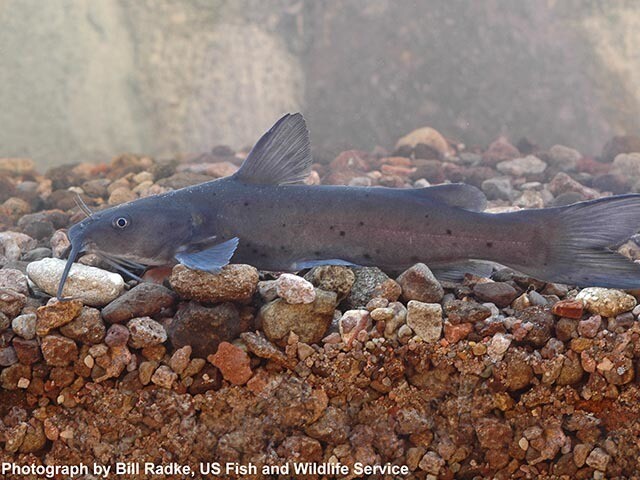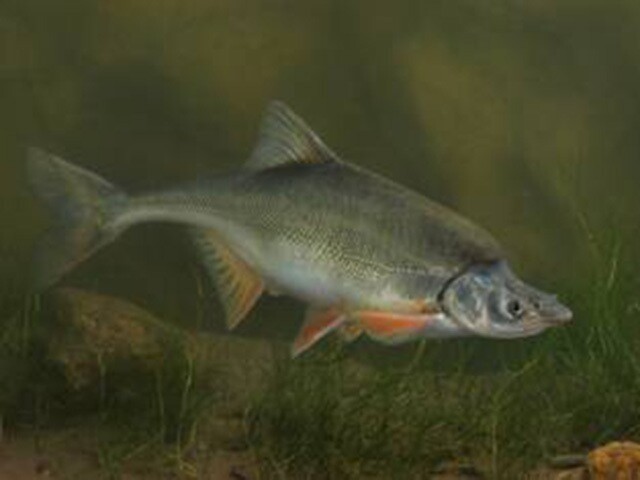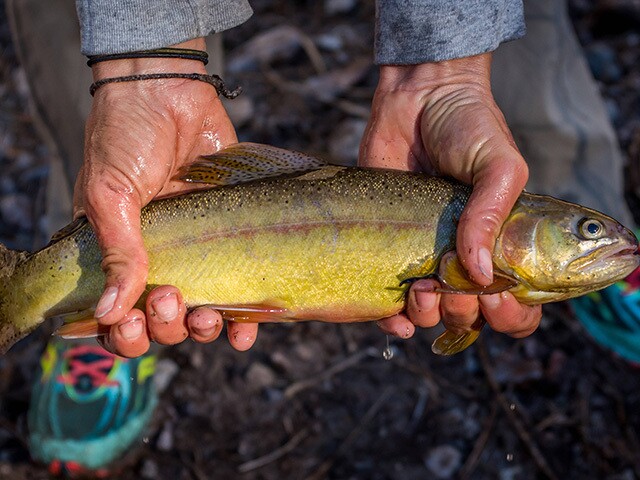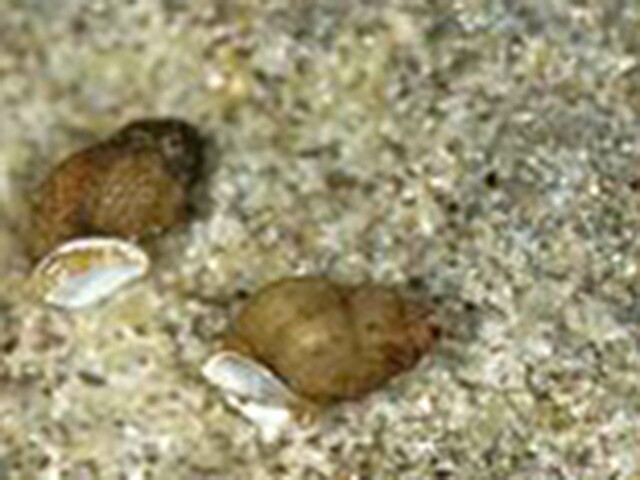Seen them? 44 endangered, threatened animals in AZ

Mexican wolf
Status: Endangered
Year listed: 1976fws.govCopyright 2017 Scripps Media, Inc. All rights reserved. This material may not be published, broadcast, rewritten, or redistributed.
Status: Endangered
Year listed: 1976fws.govCopyright 2017 Scripps Media, Inc. All rights reserved. This material may not be published, broadcast, rewritten, or redistributed.
Desert tortoise
Status: Threatened
Year listed: 1980
How to identify: Gopherus agassizii is terrestrial, with a domed shell and round, stumpy elephantine hind legs. The front limbs are flattened for digging and heavily scaled without webbed toes. The upper shell is oblong and domed with the sides round due to joining of the carapace and lower shell. The scute centers are often yellowish which have grooved concentric rings. The plastron is also yellowish, with brown along the scute margins. The head is small and rounded in front with reddish-tan coloring and the iris being greenish-yellow. azgfd.comCopyright 2017 Scripps Media, Inc. All rights reserved. This material may not be published, broadcast, rewritten, or redistributed.
Status: Threatened
Year listed: 1980
How to identify: Gopherus agassizii is terrestrial, with a domed shell and round, stumpy elephantine hind legs. The front limbs are flattened for digging and heavily scaled without webbed toes. The upper shell is oblong and domed with the sides round due to joining of the carapace and lower shell. The scute centers are often yellowish which have grooved concentric rings. The plastron is also yellowish, with brown along the scute margins. The head is small and rounded in front with reddish-tan coloring and the iris being greenish-yellow. azgfd.comCopyright 2017 Scripps Media, Inc. All rights reserved. This material may not be published, broadcast, rewritten, or redistributed.
Jaguar
Status: Endangered
Year listed: 1972
How to identify: A large, heavy-bodied, big-headed cat. Yellowish to tawny, spotted with black rosettes or rings in horizontal rows along the back and sides; most rings are tan inside, with 1 or 2 black spots. Legs, head, and tail have smaller, solid spots, usually giving way to incomplete bands near the end of the tail.fws.govCopyright 2017 Scripps Media, Inc. All rights reserved. This material may not be published, broadcast, rewritten, or redistributed.
Status: Endangered
Year listed: 1972
How to identify: A large, heavy-bodied, big-headed cat. Yellowish to tawny, spotted with black rosettes or rings in horizontal rows along the back and sides; most rings are tan inside, with 1 or 2 black spots. Legs, head, and tail have smaller, solid spots, usually giving way to incomplete bands near the end of the tail.fws.govCopyright 2017 Scripps Media, Inc. All rights reserved. This material may not be published, broadcast, rewritten, or redistributed.
Mexican Spotted owl
Status: Threatened
Year listed: 1993
How to identify: Unlike most owls, Mexican spotted owls have dark eyes. They are an ashy-chestnut brown color with white and brown spots on their abdomen, back and head. Their brown tails are marked with thin white bands. They lack ear tufts. Young owls less than 5 months old have a downy appearance. Females are larger than males.nps.govCopyright 2017 Scripps Media, Inc. All rights reserved. This material may not be published, broadcast, rewritten, or redistributed.
Status: Threatened
Year listed: 1993
How to identify: Unlike most owls, Mexican spotted owls have dark eyes. They are an ashy-chestnut brown color with white and brown spots on their abdomen, back and head. Their brown tails are marked with thin white bands. They lack ear tufts. Young owls less than 5 months old have a downy appearance. Females are larger than males.nps.govCopyright 2017 Scripps Media, Inc. All rights reserved. This material may not be published, broadcast, rewritten, or redistributed.
New Mexican Ridge-Nosed rattlesnake
Status: Threatened
Year listed: 1978
How to identify: This is a small (maximum length 66 cm) montane species that is usually pale gray to gray-brown and does not have prominent facial markings. The back is marked with pale crossbars lined with darker coloration along the front and back edges. The underside is cream to white with occasional mottling of grayish to reddish brown.Young have dark gray/black or light yellow tails.fws.govCopyright 2017 Scripps Media, Inc. All rights reserved. This material may not be published, broadcast, rewritten, or redistributed.
Status: Threatened
Year listed: 1978
How to identify: This is a small (maximum length 66 cm) montane species that is usually pale gray to gray-brown and does not have prominent facial markings. The back is marked with pale crossbars lined with darker coloration along the front and back edges. The underside is cream to white with occasional mottling of grayish to reddish brown.Young have dark gray/black or light yellow tails.fws.govCopyright 2017 Scripps Media, Inc. All rights reserved. This material may not be published, broadcast, rewritten, or redistributed.
New Mexico meadow jumping mouse
Status: Endangered
Year listed: 2014
How to identify: The jumping mouse is grayish-brown on the back, yellowish-brown on the sides, and white underneath. The species is about 7. 4 to 10 inches (187 to 255 mm) in total length, with elongated feet (1.2 inches (30.6 mm)) and an extremely long, bicolored tail (5.1 inches (130.6 mm)). The jumping mouse is a habitat specialist. It nests in dry soils, but uses moist, streamside, dense riparian/wetland vegetation up to an elevation of about 8,000 feet.usda.govCopyright 2017 Scripps Media, Inc. All rights reserved. This material may not be published, broadcast, rewritten, or redistributed.
Status: Endangered
Year listed: 2014
How to identify: The jumping mouse is grayish-brown on the back, yellowish-brown on the sides, and white underneath. The species is about 7. 4 to 10 inches (187 to 255 mm) in total length, with elongated feet (1.2 inches (30.6 mm)) and an extremely long, bicolored tail (5.1 inches (130.6 mm)). The jumping mouse is a habitat specialist. It nests in dry soils, but uses moist, streamside, dense riparian/wetland vegetation up to an elevation of about 8,000 feet.usda.govCopyright 2017 Scripps Media, Inc. All rights reserved. This material may not be published, broadcast, rewritten, or redistributed.
Chiricahua leopard frog
Status: Threatened
Year listed: 2002
How to identify: A leopard frog with a distinctive color pattern of small, raised, cream-colored spots on the thigh against a dark background with relatively rough skin on the back and sides, dorsolateral folds that are interrupted and deflected medially, and often green on the head and back. A distinctive call (a snore of 1 to 2 seconds duration) also separates this species from other leopard frogs.fws.govCopyright 2017 Scripps Media, Inc. All rights reserved. This material may not be published, broadcast, rewritten, or redistributed.
Status: Threatened
Year listed: 2002
How to identify: A leopard frog with a distinctive color pattern of small, raised, cream-colored spots on the thigh against a dark background with relatively rough skin on the back and sides, dorsolateral folds that are interrupted and deflected medially, and often green on the head and back. A distinctive call (a snore of 1 to 2 seconds duration) also separates this species from other leopard frogs.fws.govCopyright 2017 Scripps Media, Inc. All rights reserved. This material may not be published, broadcast, rewritten, or redistributed.
California condor
Status: Endangered
Year listed: 1967
How to identify: Huge and unmistakable. Black with white wing-linings and silvery panel on upper secondaries. Head naked and orange/red. Immatures with black head and underwing mottled dark. Soars on horizontal wings with primaries curled up.USFWS, U.S. Fish and Wildlife ServiceCopyright 2017 Scripps Media, Inc. All rights reserved. This material may not be published, broadcast, rewritten, or redistributed.
Status: Endangered
Year listed: 1967
How to identify: Huge and unmistakable. Black with white wing-linings and silvery panel on upper secondaries. Head naked and orange/red. Immatures with black head and underwing mottled dark. Soars on horizontal wings with primaries curled up.USFWS, U.S. Fish and Wildlife ServiceCopyright 2017 Scripps Media, Inc. All rights reserved. This material may not be published, broadcast, rewritten, or redistributed.
Northern Mexican gartersnake
Status: Threatened
Year listed: 2014
How to identify: The northern Mexican gartersnake can be difficult for people to identify. With a maximum known length of 44 inches, it ranges in background color from olive to olive-brown to olive-gray with three stripes that run the length of the body. The middle dorsal stripe is yellow and darkens toward the tail. The pale yellow to light-tan lateral stripes distinguish the Mexican gartersnake from other sympatric gartersnake species.usfws.govCopyright 2017 Scripps Media, Inc. All rights reserved. This material may not be published, broadcast, rewritten, or redistributed.
Status: Threatened
Year listed: 2014
How to identify: The northern Mexican gartersnake can be difficult for people to identify. With a maximum known length of 44 inches, it ranges in background color from olive to olive-brown to olive-gray with three stripes that run the length of the body. The middle dorsal stripe is yellow and darkens toward the tail. The pale yellow to light-tan lateral stripes distinguish the Mexican gartersnake from other sympatric gartersnake species.usfws.govCopyright 2017 Scripps Media, Inc. All rights reserved. This material may not be published, broadcast, rewritten, or redistributed.
Bonytail chub
Status: Endangered
Year listed: 1980fwc.govCopyright 2017 Scripps Media, Inc. All rights reserved. This material may not be published, broadcast, rewritten, or redistributed.
Status: Endangered
Year listed: 1980fwc.govCopyright 2017 Scripps Media, Inc. All rights reserved. This material may not be published, broadcast, rewritten, or redistributed.
Ocelot
Status: Endangered
Year listed: 1972
How to identify: Ground colours of the short fur of the ocelot, varies from creamy, or tawny yellow, to reddish grey and grey. The underside of the body, tail, and insides of the limbs is whitish. The chain-like spots are bordered with black. Ocelots have both solid and open dark spots which sometimes run in lines along the body. Solid black spots mark the head and limbs. There are two black stripes on the cheeks and one or two transverse bars on the insides of the forelegs. The tail is either ringed or marked with dark bars on its upper surface.fws.govCopyright 2017 Scripps Media, Inc. All rights reserved. This material may not be published, broadcast, rewritten, or redistributed.
Status: Endangered
Year listed: 1972
How to identify: Ground colours of the short fur of the ocelot, varies from creamy, or tawny yellow, to reddish grey and grey. The underside of the body, tail, and insides of the limbs is whitish. The chain-like spots are bordered with black. Ocelots have both solid and open dark spots which sometimes run in lines along the body. Solid black spots mark the head and limbs. There are two black stripes on the cheeks and one or two transverse bars on the insides of the forelegs. The tail is either ringed or marked with dark bars on its upper surface.fws.govCopyright 2017 Scripps Media, Inc. All rights reserved. This material may not be published, broadcast, rewritten, or redistributed.
Black-Footed ferret
Status: Endangered
Year listed: 1967
How to identify: The black-footed ferret is 18 to 24 inches long, including a 5 to 6 inch tail. It weighs only one-and-a-half to two-and-a-half pounds, with males slightly larger than females. The black-footed ferret is well adapted to its prairie environment. Its color and markings blend so well with grassland soils and plants, that it is hard to detect until it moves. fws.govCopyright 2017 Scripps Media, Inc. All rights reserved. This material may not be published, broadcast, rewritten, or redistributed.
Status: Endangered
Year listed: 1967
How to identify: The black-footed ferret is 18 to 24 inches long, including a 5 to 6 inch tail. It weighs only one-and-a-half to two-and-a-half pounds, with males slightly larger than females. The black-footed ferret is well adapted to its prairie environment. Its color and markings blend so well with grassland soils and plants, that it is hard to detect until it moves. fws.govCopyright 2017 Scripps Media, Inc. All rights reserved. This material may not be published, broadcast, rewritten, or redistributed.
Sonora Tiger Salamander
Status: Endangered
Year listed: 1997
How to identify: Tiger salamanders are large and stocky, 3.0-6.5 in., with small eyes, broad rounded snout, no parotid glands, and tubercles on the underside of front and hind feet. The dorsum has yellow to dark olive spots and blotches (reticulation), often with irregular edges between front and hind limbs.azgfd.govCopyright 2017 Scripps Media, Inc. All rights reserved. This material may not be published, broadcast, rewritten, or redistributed.
Status: Endangered
Year listed: 1997
How to identify: Tiger salamanders are large and stocky, 3.0-6.5 in., with small eyes, broad rounded snout, no parotid glands, and tubercles on the underside of front and hind feet. The dorsum has yellow to dark olive spots and blotches (reticulation), often with irregular edges between front and hind limbs.azgfd.govCopyright 2017 Scripps Media, Inc. All rights reserved. This material may not be published, broadcast, rewritten, or redistributed.
Sonoran pronghorn
Status: Endangered
Year listed: 1967
How to identify: There are five recognized subspecies. The relationships and taxonomic validity of these subspecies are poorly known, and many uncertainties exist about their ranges.fws.govCopyright 2017 Scripps Media, Inc. All rights reserved. This material may not be published, broadcast, rewritten, or redistributed.
Status: Endangered
Year listed: 1967
How to identify: There are five recognized subspecies. The relationships and taxonomic validity of these subspecies are poorly known, and many uncertainties exist about their ranges.fws.govCopyright 2017 Scripps Media, Inc. All rights reserved. This material may not be published, broadcast, rewritten, or redistributed.
Narrow-headed gartersnake
Status: Threatened
Year listed: 2014Dustin A. Wood USGSCopyright 2017 Scripps Media, Inc. All rights reserved. This material may not be published, broadcast, rewritten, or redistributed.
Status: Threatened
Year listed: 2014Dustin A. Wood USGSCopyright 2017 Scripps Media, Inc. All rights reserved. This material may not be published, broadcast, rewritten, or redistributed.
Southwestern Willow flycatcher
Status: Endangered
Year listed: 1995
How to identify: Small; usually a little less than 6 inches in length, including tail. Conspicuous light-colored wingbars. Lacks the conspicuous pale eye-ring of many similar Empidonax species. Overall, body brownish-olive to gray-green above. Throat whitish, breast pale olive, and belly yellowish. Bill relatively large; lower mandible completely pale. Best identified by vocalizations. usda.govCopyright 2017 Scripps Media, Inc. All rights reserved. This material may not be published, broadcast, rewritten, or redistributed.
Status: Endangered
Year listed: 1995
How to identify: Small; usually a little less than 6 inches in length, including tail. Conspicuous light-colored wingbars. Lacks the conspicuous pale eye-ring of many similar Empidonax species. Overall, body brownish-olive to gray-green above. Throat whitish, breast pale olive, and belly yellowish. Bill relatively large; lower mandible completely pale. Best identified by vocalizations. usda.govCopyright 2017 Scripps Media, Inc. All rights reserved. This material may not be published, broadcast, rewritten, or redistributed.
Lesser Long-Nosed bat
Status: Endangered
Year listed: 1988
How to identify: A yellow-brown or cinnamon gray bat, with a total head and body measurement of approximately 3 inches (7.62 cm). The tongue measures approximately the same length as the body. This species also has a small noseleaf. The wingspan of L. curasoae is approximately 10 inches (25 cm) and the mass is roughly 23 gazgfd.govCopyright 2017 Scripps Media, Inc. All rights reserved. This material may not be published, broadcast, rewritten, or redistributed.
Status: Endangered
Year listed: 1988
How to identify: A yellow-brown or cinnamon gray bat, with a total head and body measurement of approximately 3 inches (7.62 cm). The tongue measures approximately the same length as the body. This species also has a small noseleaf. The wingspan of L. curasoae is approximately 10 inches (25 cm) and the mass is roughly 23 gazgfd.govCopyright 2017 Scripps Media, Inc. All rights reserved. This material may not be published, broadcast, rewritten, or redistributed.
Spikedace
Status: Endangered
Year listed: 1986USFWSCopyright 2017 Scripps Media, Inc. All rights reserved. This material may not be published, broadcast, rewritten, or redistributed.
Status: Endangered
Year listed: 1986USFWSCopyright 2017 Scripps Media, Inc. All rights reserved. This material may not be published, broadcast, rewritten, or redistributed.
Woundfin
Status: Endangered
Year listed: 1970commons.wikimedia.orgCopyright 2017 Scripps Media, Inc. All rights reserved. This material may not be published, broadcast, rewritten, or redistributed.
Status: Endangered
Year listed: 1970commons.wikimedia.orgCopyright 2017 Scripps Media, Inc. All rights reserved. This material may not be published, broadcast, rewritten, or redistributed.
Yaqui chub
Status: Endangered
Year listed: 1984
How to identify: A small fresh-water fish that lives in the quiet waters of streams and has adapted well to living in ponds on the Refuge. Historical range included the Rio Yaqui drainage in the U.S. and Mexicofws.govCopyright 2017 Scripps Media, Inc. All rights reserved. This material may not be published, broadcast, rewritten, or redistributed.
Status: Endangered
Year listed: 1984
How to identify: A small fresh-water fish that lives in the quiet waters of streams and has adapted well to living in ponds on the Refuge. Historical range included the Rio Yaqui drainage in the U.S. and Mexicofws.govCopyright 2017 Scripps Media, Inc. All rights reserved. This material may not be published, broadcast, rewritten, or redistributed.
Zuni Bluehead Sucker
Status: Endangered
Year listed: 2014
Status: Endangered
Year listed: 2014
fws.govCopyright 2017 Scripps Media, Inc. All rights reserved. This material may not be published, broadcast, rewritten, or redistributed.
Sonora chub
Status: Threatened
Year listed: 1986
How to identify: A small (5-7 inches), stream-dwelling minnow found only in the Rio de la Concepcion drainage in the U.S. and Mexico. The body is relatively chubby and dark-colored, with two prominent, black, lateral bands above the lateral line and a dark, oval basicaudal spot. Breeding individuals are brightly colored, with red and orange on fins and belly. Males appear to be brighter colored than females.fws.govCopyright 2017 Scripps Media, Inc. All rights reserved. This material may not be published, broadcast, rewritten, or redistributed.
Status: Threatened
Year listed: 1986
How to identify: A small (5-7 inches), stream-dwelling minnow found only in the Rio de la Concepcion drainage in the U.S. and Mexico. The body is relatively chubby and dark-colored, with two prominent, black, lateral bands above the lateral line and a dark, oval basicaudal spot. Breeding individuals are brightly colored, with red and orange on fins and belly. Males appear to be brighter colored than females.fws.govCopyright 2017 Scripps Media, Inc. All rights reserved. This material may not be published, broadcast, rewritten, or redistributed.
Masked bobwhite
Status: Endangered
Year listed: 1967
How to identify: The adult male masked bobwhite has a rich rufous-red (cinnamon) breast and a black head and throat. Some males have a white to yellowish-white superciliary stripe and sometimes touches of white elsewhere on the head. They have crowns mottled with black and rufous. The back feathers are a maze of blacks, browns, rufous and buff.The female plumage is mottled brown, buff and white with a buff throat and superciliary stripe very similar to females of other bobwhite races. fws.govCopyright 2017 Scripps Media, Inc. All rights reserved. This material may not be published, broadcast, rewritten, or redistributed.
Status: Endangered
Year listed: 1967
How to identify: The adult male masked bobwhite has a rich rufous-red (cinnamon) breast and a black head and throat. Some males have a white to yellowish-white superciliary stripe and sometimes touches of white elsewhere on the head. They have crowns mottled with black and rufous. The back feathers are a maze of blacks, browns, rufous and buff.The female plumage is mottled brown, buff and white with a buff throat and superciliary stripe very similar to females of other bobwhite races. fws.govCopyright 2017 Scripps Media, Inc. All rights reserved. This material may not be published, broadcast, rewritten, or redistributed.
Razorback sucker
Status: Endangered
Year listed: 1991nps.govCopyright 2017 Scripps Media, Inc. All rights reserved. This material may not be published, broadcast, rewritten, or redistributed.
Status: Endangered
Year listed: 1991nps.govCopyright 2017 Scripps Media, Inc. All rights reserved. This material may not be published, broadcast, rewritten, or redistributed.
Gila chub
Status: Endangered
Year listed: 2005
How to identify: A small-finned minnow with a deep and chubby body averaging 6 inches (males) with females reaching 8 inches. Deep compressed body, flat head. Dark olive-gray color above, silver sides.azgfd.govCopyright 2017 Scripps Media, Inc. All rights reserved. This material may not be published, broadcast, rewritten, or redistributed.
Status: Endangered
Year listed: 2005
How to identify: A small-finned minnow with a deep and chubby body averaging 6 inches (males) with females reaching 8 inches. Deep compressed body, flat head. Dark olive-gray color above, silver sides.azgfd.govCopyright 2017 Scripps Media, Inc. All rights reserved. This material may not be published, broadcast, rewritten, or redistributed.
Hualapai Mexican vole
Status: Endangered
Year listed: 1987
How to identify: A rodent that is about 4-6 inches long. It has cinnamon brown and black fur, a short tail, and long fur that nearly covers its small round ears. It lives in forests with pine trees and grassy meadows.fws.govCopyright 2017 Scripps Media, Inc. All rights reserved. This material may not be published, broadcast, rewritten, or redistributed.
Status: Endangered
Year listed: 1987
How to identify: A rodent that is about 4-6 inches long. It has cinnamon brown and black fur, a short tail, and long fur that nearly covers its small round ears. It lives in forests with pine trees and grassy meadows.fws.govCopyright 2017 Scripps Media, Inc. All rights reserved. This material may not be published, broadcast, rewritten, or redistributed.
Yaqui catfish
Status: Threatened
Year listed: 1984
How to identify: A fresh-water fish found in quiet-water habitats associated with larger streams and ponds of the Rio Yaqui drainagefws.govCopyright 2017 Scripps Media, Inc. All rights reserved. This material may not be published, broadcast, rewritten, or redistributed.
Status: Threatened
Year listed: 1984
How to identify: A fresh-water fish found in quiet-water habitats associated with larger streams and ponds of the Rio Yaqui drainagefws.govCopyright 2017 Scripps Media, Inc. All rights reserved. This material may not be published, broadcast, rewritten, or redistributed.
Beautiful shiner
Status: Threatened
Year listed: 1984
How to identify: The beautiful shiner inhabits small streams and ponds in the Rio Yaqui drainage of Arizona and Mexico. It was historically found in the Mimbres drainage in New Mexico. The male shiner in breeding colors, with yellow-orange or orange fins and a bluish body.fws.govCopyright 2017 Scripps Media, Inc. All rights reserved. This material may not be published, broadcast, rewritten, or redistributed.
Status: Threatened
Year listed: 1984
How to identify: The beautiful shiner inhabits small streams and ponds in the Rio Yaqui drainage of Arizona and Mexico. It was historically found in the Mimbres drainage in New Mexico. The male shiner in breeding colors, with yellow-orange or orange fins and a bluish body.fws.govCopyright 2017 Scripps Media, Inc. All rights reserved. This material may not be published, broadcast, rewritten, or redistributed.
Yuma Clapper rail
Status: Endangered
Year listed: 1967
How to identify: A marsh bird the size of a chicken, the Yuma clapper rail is gray-brown above and buffy-cinnamon below, mottled brown or gray on its rump and has brownish-gray cheeks and flanks barred with black and white. Its somewhat orange bill is long, slender and slightly down-curved. The Yuma clapper rail is a water bird with long legs and a short tail.fws.govCopyright 2017 Scripps Media, Inc. All rights reserved. This material may not be published, broadcast, rewritten, or redistributed.
Status: Endangered
Year listed: 1967
How to identify: A marsh bird the size of a chicken, the Yuma clapper rail is gray-brown above and buffy-cinnamon below, mottled brown or gray on its rump and has brownish-gray cheeks and flanks barred with black and white. Its somewhat orange bill is long, slender and slightly down-curved. The Yuma clapper rail is a water bird with long legs and a short tail.fws.govCopyright 2017 Scripps Media, Inc. All rights reserved. This material may not be published, broadcast, rewritten, or redistributed.
Loach minnow
Status: Endangered
Year listed: 1986
How to identify: A small member of the minnow family with an elongated body that is flattened ventrally. There are eight rays in the dorsal fin and seven in the anal fin. The lateral line has approximately 65 scales. Coloration tends to be olivaceous background, with a lot of blotches in darker pigments. There are whitish spots at the origin and insertion of the dorsal fin and dorsal and ventral portions of the caudal fin base. A black, basicaudal spot is usually present. azgfd.govCopyright 2017 Scripps Media, Inc. All rights reserved. This material may not be published, broadcast, rewritten, or redistributed.
Status: Endangered
Year listed: 1986
How to identify: A small member of the minnow family with an elongated body that is flattened ventrally. There are eight rays in the dorsal fin and seven in the anal fin. The lateral line has approximately 65 scales. Coloration tends to be olivaceous background, with a lot of blotches in darker pigments. There are whitish spots at the origin and insertion of the dorsal fin and dorsal and ventral portions of the caudal fin base. A black, basicaudal spot is usually present. azgfd.govCopyright 2017 Scripps Media, Inc. All rights reserved. This material may not be published, broadcast, rewritten, or redistributed.
Apache trout
Status: Threatened
Year listed: 1967
How to identify: The Apache trout is a species of freshwater fish and is a member of the Salmonidae family. Feeding preferences depend on size. Fish 6-9cm long primarily feed on Ephemeroptera, whereas fish 15cm and larger utilize more Trichoptera, and terrestrial insects are eaten by all size classes. fws.govCopyright 2017 Scripps Media, Inc. All rights reserved. This material may not be published, broadcast, rewritten, or redistributed.
Status: Threatened
Year listed: 1967
How to identify: The Apache trout is a species of freshwater fish and is a member of the Salmonidae family. Feeding preferences depend on size. Fish 6-9cm long primarily feed on Ephemeroptera, whereas fish 15cm and larger utilize more Trichoptera, and terrestrial insects are eaten by all size classes. fws.govCopyright 2017 Scripps Media, Inc. All rights reserved. This material may not be published, broadcast, rewritten, or redistributed.
California Least tern
Status: Endangered
Year listed: 1970
How to identify: Long, narrow wings and a broad, forked tail identify the California least tern. Also have black-capped head and black-tipped, pale gray wings of the least tern contrast with its white body. It bears a white blaze across its forehead, dark forewings, black-tipped yellow bill, and yellowish feet. Is less the 25 cm when full grown and has 75 cm wingspan.fws.govCopyright 2017 Scripps Media, Inc. All rights reserved. This material may not be published, broadcast, rewritten, or redistributed.
Status: Endangered
Year listed: 1970
How to identify: Long, narrow wings and a broad, forked tail identify the California least tern. Also have black-capped head and black-tipped, pale gray wings of the least tern contrast with its white body. It bears a white blaze across its forehead, dark forewings, black-tipped yellow bill, and yellowish feet. Is less the 25 cm when full grown and has 75 cm wingspan.fws.govCopyright 2017 Scripps Media, Inc. All rights reserved. This material may not be published, broadcast, rewritten, or redistributed.
Gila trout
Status: Threatened
Year listed: 1967fws.govCopyright 2017 Scripps Media, Inc. All rights reserved. This material may not be published, broadcast, rewritten, or redistributed.
Status: Threatened
Year listed: 1967fws.govCopyright 2017 Scripps Media, Inc. All rights reserved. This material may not be published, broadcast, rewritten, or redistributed.
Humpback chub
Status: Endangered
Year listed: 1967nps.govCopyright 2017 Scripps Media, Inc. All rights reserved. This material may not be published, broadcast, rewritten, or redistributed.
Status: Endangered
Year listed: 1967nps.govCopyright 2017 Scripps Media, Inc. All rights reserved. This material may not be published, broadcast, rewritten, or redistributed.
Desert pupfish
Status: Endangered
Year listed: 1986
How to identify: Small (2 inches) smoothly rounded body shape with narrow vertical bars on the sides. Breeding males blue on head and sides with yellow on tail. Females and juveniles tan to olive colored back and silvery sides. wildlife.ca.govCopyright 2017 Scripps Media, Inc. All rights reserved. This material may not be published, broadcast, rewritten, or redistributed.
Status: Endangered
Year listed: 1986
How to identify: Small (2 inches) smoothly rounded body shape with narrow vertical bars on the sides. Breeding males blue on head and sides with yellow on tail. Females and juveniles tan to olive colored back and silvery sides. wildlife.ca.govCopyright 2017 Scripps Media, Inc. All rights reserved. This material may not be published, broadcast, rewritten, or redistributed.
Yellow-Billed Cuckoo
Status: Threatened
Year listed: 2014
How to identify: Fairly large, long, and slim birds. The mostly yellow bill is almost as long as the head, thick and slightly downcurved. They have a flat head, thin body, and very long tail. Wings appear pointed and swept back in flight. Yellow-billed Cuckoos are warm brown above and clean whitish below. Their blackish face mask is accompanied by a yellow eyering.fws.govCopyright 2017 Scripps Media, Inc. All rights reserved. This material may not be published, broadcast, rewritten, or redistributed.
Status: Threatened
Year listed: 2014
How to identify: Fairly large, long, and slim birds. The mostly yellow bill is almost as long as the head, thick and slightly downcurved. They have a flat head, thin body, and very long tail. Wings appear pointed and swept back in flight. Yellow-billed Cuckoos are warm brown above and clean whitish below. Their blackish face mask is accompanied by a yellow eyering.fws.govCopyright 2017 Scripps Media, Inc. All rights reserved. This material may not be published, broadcast, rewritten, or redistributed.
Three Forks Springsnail
Status: Endangered
Year listed: 2012fws.govCopyright 2017 Scripps Media, Inc. All rights reserved. This material may not be published, broadcast, rewritten, or redistributed.
Status: Endangered
Year listed: 2012fws.govCopyright 2017 Scripps Media, Inc. All rights reserved. This material may not be published, broadcast, rewritten, or redistributed.
Gila topminnow
Status: Endangered
Year listed: 1967
How to identify: A small (2.5-5 cm), silvery, live-bearing, guppy-like fish without dark spots on the fins. Males in breeding color are black with yellow fins. fws.govCopyright 2017 Scripps Media, Inc. All rights reserved. This material may not be published, broadcast, rewritten, or redistributed.
Status: Endangered
Year listed: 1967
How to identify: A small (2.5-5 cm), silvery, live-bearing, guppy-like fish without dark spots on the fins. Males in breeding color are black with yellow fins. fws.govCopyright 2017 Scripps Media, Inc. All rights reserved. This material may not be published, broadcast, rewritten, or redistributed.
Little Colorado spinedace
Status: Threatened
Year listed: 1967
How to identify: A small (about 4 inches) silvery minnow. There are minimal differences between the sexes. The pectoral fin on males is larger than females, but both males and females are relatively the same size. During breeding season the bases of paired fins in males has been described as turning an intense reddish-orange, or a wash of weak yellow or orange. azgfd.govCopyright 2017 Scripps Media, Inc. All rights reserved. This material may not be published, broadcast, rewritten, or redistributed.
Status: Threatened
Year listed: 1967
How to identify: A small (about 4 inches) silvery minnow. There are minimal differences between the sexes. The pectoral fin on males is larger than females, but both males and females are relatively the same size. During breeding season the bases of paired fins in males has been described as turning an intense reddish-orange, or a wash of weak yellow or orange. azgfd.govCopyright 2017 Scripps Media, Inc. All rights reserved. This material may not be published, broadcast, rewritten, or redistributed.
Colorado pikeminnow
Status: Endangered
Year listed: 1967
Status: Endangered
Year listed: 1967
nps.govCopyright 2017 Scripps Media, Inc. All rights reserved. This material may not be published, broadcast, rewritten, or redistributed.
San Bernardino springsnail
Status: Threatened
Year listed: 2012
How to identify: A narrow-conic shell, height 1.3 to 1.7 mm, and 3.25-4.0 whorls (twists); operculum (shell opening) ovate and light amber, central radular tooth with indented dorsal edge, cephalic tentacles pale, snout (nose) pale to gray-black, foot pale, opercular lobe black, and neck pale. Ctenidial filaments (gills) 14, are short and narrow. fws.govCopyright 2017 Scripps Media, Inc. All rights reserved. This material may not be published, broadcast, rewritten, or redistributed.
Status: Threatened
Year listed: 2012
How to identify: A narrow-conic shell, height 1.3 to 1.7 mm, and 3.25-4.0 whorls (twists); operculum (shell opening) ovate and light amber, central radular tooth with indented dorsal edge, cephalic tentacles pale, snout (nose) pale to gray-black, foot pale, opercular lobe black, and neck pale. Ctenidial filaments (gills) 14, are short and narrow. fws.govCopyright 2017 Scripps Media, Inc. All rights reserved. This material may not be published, broadcast, rewritten, or redistributed.













